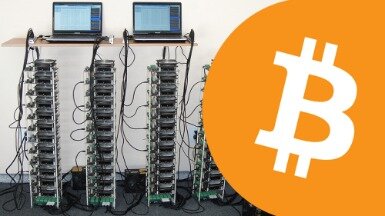Content
Those who do not own a personal rig or hold enough funds to build a rig may find GPU mining much easier on their pockets. Thus, CPU mining generates small revenue which remains either equivalent or less than your electricity bill. By definition, CPU Mining is a term in use for processor-based cryptocurrency mining.
Therefore the community performs a large number of hashing by modifying a random component of the block content until, by chance, someone finds a “valid” hash that is smaller than the threshold. This is called proof of work and serves the purpose to determine majority consensus. Indeed, in an anonymous distributed system, participants can arbitrarily generate new identities so consensus cannot be accounted in terms of individuals. Rather, it must be accounted in terms of some participation cost demonstrating the commitment of computational power.

According to kvorc, the antivirus industry could also review what it sees as threats, claiming that although mining tools can be processor hungry, they are not significantly worse than many adverts that are not flagged. “It’s funny how they don’t flag flashy cookie ads as malware, but using CPU cycles that would otherwise be used by bad JavaScript in adverts is somehow dangerous,” he says. Although the abuse risks ruining this nascent technology before most people have even heard of it, industry watchers believe that CPU mining could actually work as a web currency. With advertising revenue increasingly hard to come by due to the dominance of Google and the increased use of ad-blockers, mining could provide an alternative revenue stream. The site had given no notice, nor offered any opt-out for the mining script.
Similarly, cryptocurrency mining is a type of digital Mining where a miner completes several tasks. And, receives bitcoin or several bitcoins in the form of reward. Several questions sprained their minds to overthink risks, pros, and cons for the fresh cryptocurrency miners. So let’s explore some basic information on cryptocurrency mining to get ready for earning crypto money in the future.
Alternus Energy Shows Turn To Positive Ebitda And Strong Revenue ..
There are a variety of these available, depending on your operating . We could therefore conclude that in the Bitcoin network the cost of proof of work is not at all too high. On the contrary it is actually too low to protect against double spending attacks. However, the proof of work is not the sole mechanism that provides protection of the Bitcoin network. The system also depends upon the high entry barriers in terms of mining hardware and facilities costs.
How long does it take to mine 1 Bitcoin?
Regardless of the number of miners, it still takes 10 minutes to mine one Bitcoin. At 600 seconds (10 minutes), all else being equal it will take 72,000 GW (or 72 Terawatts) of power to mine a Bitcoin using the average power usage provided by ASIC miners.
But with the price of Bitcoin increasing almost daily, the potential payoff is growing higher as well. However, the increasing cost of mining equipment is eating away at potential returns. It’s unclear exactly how much energy Bitcoin uses, but one study estimates that Bitcoin’s total energy consumption is somewhere between 40 and 445 annualized terawatt-hours with a central estimate of about 130TWh. That’s around the same level of power consumption as the Netherlands. The fact that miners require so much energy in solving these problems is starting to attract significant negative publicity.
How Much One Could Earn By Mining Bitcoin
Bitcoin may well have merit above and beyond making miners rich, but compared to traditional payment systems — gold, cash, credit cards — is it an energy hog? The consumption range leaves bitcoin either much more expensive in terms of energy than existing transactional systems or much cheaper. Not including fees and electricity – I would say £19 a day isn’t exactly shabby. Even with the fees and energy it’s still going to be over £10 a day. Probably in the region of 350w for mining with that spec. In order to read or download cryptocurrency for beginners how to make a lot of money investing and trading in cryptocurrency pdf ebook, you need to create a FREE account.
When you pass a word through SHA-256, you will be given back an unrecognisable string of letters and numbers called a “HASH”. For a more detailed explanation of the blockchain, check out our guide here. As such, even if a cloud mining contract looks like it will be profitable, you’re still more likely to lose more than you earn.
Further, Bitcoin value is built upon community trust so once a majority attack has been detected, the Bitcoin value is likely to collapse together with the potential attacker gains. Finally, an attack involving a large fraction of the Bitcoin volume would be most likely detected by the network before its completion. A mining hardware has an energy consumption that can be measured in joules per terahash (J/Th), and has a hashing speed that can be measured in terahashes per second (Th/s).
Miners take a new block and apply a mathematical formula to the information in the block. This turns it into a random sequence of letters and numbers called a hash. The hash is stored along with the block, at the end of the blockchain at that point in time. But, as bitcoin evolved, the mining process grew more intense.
Mining Pools
In addition to this, their outdated method of measuring consumption, using consumption data from 2014 puts their results into serious question. Remember that electricity consumption for Bitcoin mining has quadrupled over the last year. Given that the most recent CPUs added will be more efficient than the older CPUs implies that the number of mining CPUs is growing faster than electricity consumption, possibly much faster. As such, if small scale mining is profitable now, it will become less so in future unless CPU efficiency grows in line with mining difficulty . But even if CPU efficiency does increase to offset increases in mining difficulty it will only help the bitcoin miner if they are constantly replacing their rigs with the most efficient units available and that is not practical on a small scale.
Therefore, the general public doesn’t hold the financial power and stability to buy cryptocurrency. It permits interested individuals to complete tasks online and receive rewards in the form of cryptocurrency like bitcoin. To offset the difficulty of mining a block, miners started organising in pools or cloud mining networks. Whenever a miner in one of these pools solves a block, the reward is shared with everyone in the pool in a ratio representative of how much work you put into the pool . As of November 2017, a regular home computer working alone, i.e., not an application-specific integrated circuit and not part of a cloud mining network, would take 2.7 million years to mine one block. It’s estimated that today there are more than 1 million Bitcoin miners in operation, all competing for that next block to add to the chain every 10 minutes.
The more intense the mining process, the more resilient bitcoin becomes. Nakamoto wanted a system of money whose purchasing power increases over time, so he limited money supply to a maximum of 21 million coins. His ingenious solution to it all was what he called mining. The reason bitcoin works so well is because it uses so much power.
That’s more than Digiconomist’s figure, but that methodology has other inputs. And thousands of bitcoin mining operations around the world – thousands of powerful computers – compete with each other to mine the block and get the bitcoin reward. It is the combined power of all these computers that processes all the transactions and maintains the network. It could be done by a standard PC, as long as it was running 24/7. However, as transaction volume has increased, block construction became more and more complex.
Where Do I Store My Mined Bitcoin?
One can notice that the cost of one gigajoule of energy has two distinct levels—around 20 USD from 2011 to mid 2014 and around 10 USD from late 2014 to early 2020. Oil prices has since collapsed under the coronavirus pandemic, dropping to below 3 USD per gigajoule of energy.
Distributed systems and Blockchains can be secured through several other mechanisms that do not require computationally intensive proof of work. Indeed the proof of work is a mechanism introduced to produce qualified voters in a system of anonymous untrustful parties. Any mechanism that can verify identity of the voters’ or that can in any other way avoid uncontrolled duplications of the voters can reduce or eliminate completely the cost and even the need of a proof of work. However, these other mechanisms must relax also some other properties, such as anonymity, openness, or equalitarian distributed verification.
As the infrastructure required to support the cryptocurrency has grown and developed, so has the value of Bitcoin as more and more investors and institutions have bought into the idea of the decentralized currency. While Bitcoin and the idea of a social cryptocurrency had been around for nearly two decades, Bitcoin hadn’t really attracted much attention until 2017. Aside from pushing for more efficient hardware, there are other “proof” techniques that are less demanding, though may introduce security concerns. Proof of stake is the frequently mooted solution which uses a less demanding system to prove ownership of coins and dole them out via a raffle-like scheme, Vranken says. There’s also proof of space, which he explains sees the miner use a specified amount of memory to compute the proof. There’s also proof-of-space-time, which adds in a temporal element, but at this point that sounds a bit like he’s trolling us all. Malone has actually reduced his estimate, saying that while it’s hard to know exactly what hardware is being used, it’s likely all professional grade at this point, which is much more efficient.
- Note that this is the lower bound estimate and the actual cost is presumably much larger.
- However, that’s not the only challenge you will face if you attempt to mine yourself.
- Remember bitcoin yields nothing and its main source of value is scarcity.
- Indeed, the day-to-day growing market value of cryptocurrencies has moved the general public’s focus.
- Participants have an unlimited number of guesses and the first one to submit the correct weight wins.
Before decided which pool to join, do some research to make sure it’s a legit operation. The machines run very hot, so you have to think about cooling as well. Unless you live in a very cold country this is going to add to your costs. Also, since each block’s hash is produced by using the hash that belongs to the block that comes before it in the chain, checking a hash verifies that all the blocks that come after it are legitimate too. The properties of the hash mean it becomes like a digital wax seal. It verifies that the information in the block hasn’t been tampered with.
Bitcoin Mining: Can I Make Money Doing It?
The team at Credit Suisse also calculated the bitcoin price that would be needed to incentivise miners to gobble up all the world’s generation capacity; $1.1 million per coin. Bitcoin mining consumes energy – globally, a huge amount of energy. Use our FREE Ofgem-accredited energy comparison calculator to see how much you can save on your electricity.
The reason it moves back is because Bitcoin mining difficulty tends to rise over time, especially as Bitcoin prices do. This means the amount of Bitcoin you get from cloud mining will usually decrease over time, which pushes back the break-even point.
The blockchain makes a record every time a Bitcoin is bought or sold, with these records being assembled into a continuous line of connected ‘blocks’. In order for a transaction to be valid and go through, they need to be verified by other users on the network.

The value of Bitcoins has gone up and down over the years since it was created in 2009 and some people don’t think it’s safe to turn your ‘real’ money into Bitcoins. People can also spend their Bitcoins fairly anonymously. Although all transactions are recorded, nobody would know which ‘account number’ was yours unless you told them.
Since then, with the digital currency seeing its popularity surging, the strain on the energy network has increased. Concerns have been raised over the amount of electricity needed to mine bitcoin. If data centres full of social media photos and cat videos begin sapping the electricity grids, Bitcoin mining will probably be the least of the world’s problems. While the rewards for mining Bitcoin can be great, the demand for computing power has led to the rise of massive mining nodes made up of dozens of processors that perform trillions of calculations to try to mine as much as possible. Mining Bitcoin is an expensive business, mainly due to the extremely large electricity bill the process can ramp up and the pricey hardware involved. It’s always recommendable for miners to generate a personal cryptocurrency wallet rather than depending on your skill trainer to do so.










